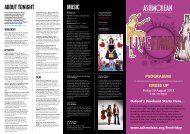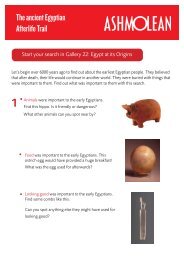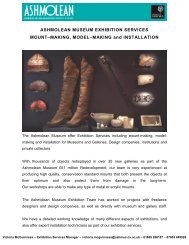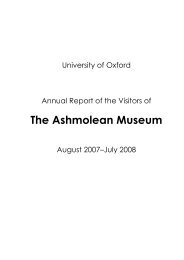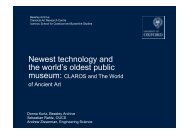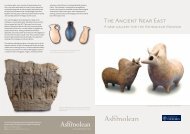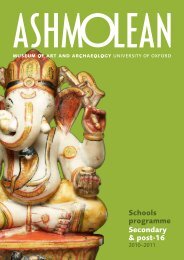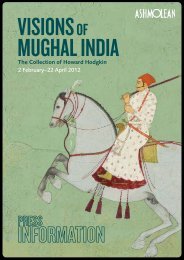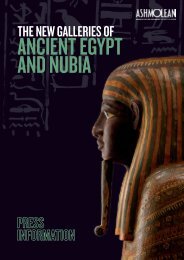Highlights of the Annual Report - The Ashmolean Museum
Highlights of the Annual Report - The Ashmolean Museum
Highlights of the Annual Report - The Ashmolean Museum
Create successful ePaper yourself
Turn your PDF publications into a flip-book with our unique Google optimized e-Paper software.
Acquisitions, gifts and loans / 33<br />
Design for a monument to Pope Clement XI (Albani)<br />
Pietro Bracci (1700-1773) (illus. on p. 28)<br />
Black chalk, pen and black and red inks, brown, grey and green washes,<br />
heightened with white gouache, on two sheets <strong>of</strong> brownish paper, 42.5 x 25.6 cm.<br />
Signed Petrus Bracci Rom. Fecit 1743 lower left and inscribed Scala di Palma Trenta<br />
Romani beneath <strong>the</strong> ground plan.<br />
Purchased (Blakiston and Miller Funds) with <strong>the</strong> assistance <strong>of</strong> <strong>the</strong> National Art<br />
Collections Fund and <strong>the</strong> Friends <strong>of</strong> <strong>the</strong> <strong>Ashmolean</strong> (WA 2003.132)<br />
Pietro Bracci was <strong>the</strong> heir to Bernini and Algardi in 18th-century Rome:<br />
essentially he worked in a late baroque manner, with a strain <strong>of</strong> classicism<br />
underlying his energy and exuberance. In this elaborate design <strong>of</strong> 1743 for an<br />
unexecuted monument, <strong>the</strong> papal sarcophagus is flanked by allegories <strong>of</strong> Strength<br />
and Religion; a scaled ground plan is included. Bracci’s use <strong>of</strong> brownish paper<br />
and coloured washes and his lavish handling <strong>of</strong> white heightening give his design<br />
a vivid sense <strong>of</strong> three dimensionality. With its evidence <strong>of</strong> revisions and<br />
corrections, <strong>the</strong> sheet also reveals <strong>the</strong> working methods <strong>of</strong> <strong>the</strong> artist.<br />
Portrait <strong>of</strong> Thomas Sanders Dupuis<br />
John Russell (1745-1806)<br />
Pastel, 59.5 x 44.1 cm<br />
Presented by <strong>the</strong> family <strong>of</strong> Mrs Joan Conway<br />
(WA 2002.204)<br />
This is one <strong>of</strong> a spectacular group <strong>of</strong> pastels by<br />
Russell collected by <strong>the</strong> art dealer Asher<br />
Wer<strong>the</strong>imer; ano<strong>the</strong>r was <strong>the</strong> celebrated<br />
portrait <strong>of</strong> a porter at <strong>the</strong> Royal Academy<br />
(Courtauld Institute Galleries, London).<br />
Thomas Sanders Dupuis (1733-1796)<br />
was appointed organist and compositor<br />
to George III in 1779, and is here shown<br />
in <strong>the</strong> gown <strong>of</strong> a Doctor <strong>of</strong> Music at Oxford,<br />
a title which he was awarded in 1790.<br />
Entrance to <strong>the</strong> Adelphi Wharf<br />
Théodore Gericault (1791-1824) (illus. over)<br />
Lithograph, 25.2 x 31.2 cm.<br />
Presented by Mrs Louisa Webb in accordance with <strong>the</strong> wishes <strong>of</strong><br />
<strong>the</strong> late Maxwell Webb (WA 2003.45)<br />
From 1820-1 Gericault was in England mainly to exhibit his<br />
great painting <strong>The</strong> Raft <strong>of</strong> <strong>the</strong> Medusa. Abandoning his former grand style,<br />
he concentrated on modern life, especially that <strong>of</strong> <strong>the</strong> London slums. <strong>The</strong><br />
result was a series <strong>of</strong> lithographs, published from January to May 1821.<br />
Entrance to <strong>the</strong> Adelphi Wharf stands out through its clear representation <strong>of</strong><br />
space and light, <strong>the</strong> supple manner <strong>of</strong> drawing, and <strong>the</strong> dense surface with its<br />
marvellous treatment <strong>of</strong> <strong>the</strong> shadows.




